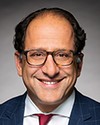Okay.
It's been repeated time and again that 1% of the seizures happen at the border. For every 1% that you seize, how many fall through the cracks?
Evidence of meeting #3 for Public Safety and National Security in the 45th Parliament, 1st session. (The original version is on Parliament’s site, as are the minutes.) The winning word was plan.
Conservative

Chak Au Conservative Richmond Centre—Marpole, BC
Okay.
It's been repeated time and again that 1% of the seizures happen at the border. For every 1% that you seize, how many fall through the cracks?
Vice-President, Intelligence and Enforcement, Canada Border Services Agency
Well, there are two things.
I think the 1% is perhaps a stat that Gerard was referring to in terms of CBP seizures and the amount of fentanyl. That doesn't reflect the CBSA experience in terms of seizures.
It's impossible for us to know. We don't know what the denominator is. We're very effective in terms of what we're doing. We've seized large amounts of cannabis, cocaine and methamphetamine this year, as well as the fentanyl, but absent seizures, we don't know what we don't know.
Conservative

Chak Au Conservative Richmond Centre—Marpole, BC
Would that figure be misleading? You know, 1% seems to be insignificant, but actually we know the problem is much bigger.
Vice-President, Intelligence and Enforcement, Canada Border Services Agency
If you're talking about the U.S. seizures, I'll let Mr. Peets respond.
Assistant Deputy Minister, Canada’s Fight Against Fentanyl, Privy Council Office
Thanks very much.
This is just to note that I'm having a bit of Coca-Cola here because I'm type 1 diabetic. I'm just getting some sugar in me. I'll let you know if I have any issues.
Importantly, on the seizures, my figure was one-tenth of 1%. That is comparing apples to apples. It's American data and it's comparing American data on the northern border with American data on the southern border.
To give an example of some of the recent numbers, in August 2025, just this past month, the U.S. CBP seized two and a quarter pounds in what they call the northern border region, and they seized 679 pounds in what they call the southern border region. If you look at the trend over the last few years of U.S. data and divide the Canadian data as a portion of the total, it's less than one-tenth of 1%.
I shouldn't have said “Canadian”. It's the amount seized in what the U.S. CBP attributes to the northern border region, which may or may not come from Canada.
Conservative

Chak Au Conservative Richmond Centre—Marpole, BC
Okay.
Do you have the number of organized crime groups that you have been monitoring and identifying? How many groups are you looking at right now?
Executive Director, Federal Policing, Royal Canadian Mounted Police
I can answer that question.
From an organized crime perspective, we rely on the Canadian Security Intelligence Service. They have recently come out with their latest report, which is available online. If I'm not mistaken, they cite 350 organized crime groups operating in Canada that have the capability of manufacturing and trafficking in fentanyl.
I don't know off the top of my head what the total number of organized crime groups is, but that is their recent number in terms of who may be involved in the market here on Canadian soil.
Conservative

Chak Au Conservative Richmond Centre—Marpole, BC
How effective have you been in monitoring these groups?
Executive Director, Federal Policing, Royal Canadian Mounted Police
It's a shared responsibility. It's not just the RCMP. We're the police of jurisdiction in many parts of the country, but not the entirety of the country. We work very closely with an organization called CIROC, which is the Canadian integrated response to organized crime, in which the 36 largest police forces in the country come together.
We've been undertaking fentanyl sprints now for the last several months. We had one early in the calendar year, in January and February. We're completing one right now. We should have the results in early November, which will be announced publicly through a press conference.
When you think about some of my earlier comments around the importance of partnerships and integration across law enforcement at all levels of policing and with our federal partners, this is a prime example of where we're having a sustained impact on the fentanyl trafficking issue within Canada by working together with our partners across the country.
Liberal

The Chair Liberal Jean-Yves Duclos
Thank you, Mr. Au. I'm sorry, but your five minutes are already over.
I'll turn to MP Ehsassi, and then Madame DeBellefeuille.

Ali Ehsassi Liberal Willowdale, ON
Thank you, Mr. Chair. I'm very grateful. Thank you, also, to all the witnesses. This has been very helpful.
I'll start off my questions with Mr. McCrorie.
Recently, a few of us had the opportunity to go to the Gordie Howe bridge. They were very pleased with their new imaging technology. For every significant crossing we have at the border, do we have imaging technology deployed?
Vice-President, Commercial and Trade Branch, Canada Border Services Agency
The deployment of imaging technology depends on the risk, the infrastructure and a number of other factors. Right now, Gordie Howe does have large-scale imaging, as does Vancouver. Those are fixed. The CBSA deploys more mobile technology and moves it around based on operational requirements.
To your question as to whether we are deploying based on the trends with respect to the importation of fentanyl and guns, yes, we are. It depends on risk. Not all ports of entry have fixed, large-scale imaging like what you would have seen at the Gordie Howe International Bridge.
Liberal

Ali Ehsassi Liberal Willowdale, ON
As I understand it, only two of those crossings definitely have it. Others could conceivably have it. Do we plan on expanding it to all the significant border crossings?
Vice-President, Commercial and Trade Branch, Canada Border Services Agency
At this point in time, we've invested in mobile technology. For example, we are taking possession of a number of backscatter imaging units in, I believe, the last quarter, which is early next year. Those will be deployed to certain ports of entry to do scanning where we have deemed the risk to be high.
In terms of further deployment of fixed, large-scale imaging, at this point in time we have no plans.
Liberal

Ali Ehsassi Liberal Willowdale, ON
In your opinion, or in Mr. McCrorie's opinion, is that sufficient, or is that something you'd like to see considered?
Vice-President, Intelligence and Enforcement, Canada Border Services Agency
Again, I would reflect on the importance of taking an intelligence-based approach to this and understanding where you're targeting your efforts. The technology is a tool, and—
Liberal

Abdelhaq Sari Liberal Bourassa, QC
Mr. Chair, on a point of order. I understand English, but I am listening to the interpretation and the sound is cutting out a little.
Since the interpretation is being done remotely, I would ask the interpreter to disconnect and reconnect. That might solve the problem.
Liberal

The Chair Liberal Jean-Yves Duclos
I usually listen to the floor channel, but I was listening to the interpretation earlier and it was working. That said, if I understand correctly, it works inconsistently.
Bloc

Claude DeBellefeuille Bloc Beauharnois—Salaberry—Soulanges—Huntingdon, QC
The sound is like that of a robot.
Liberal

The Chair Liberal Jean-Yves Duclos
There really is a connection problem. We will come back to this before the end of the meeting. I will summarize the points relating to interpretation that will need to be reviewed before the next meeting.
In the meantime, I invite officials to do what they can, given the situation.
Vice-President, Intelligence and Enforcement, Canada Border Services Agency
The point I was going to make was that the technology is a tool, and you don't use a hammer to saw a board. What's great about X-ray technology is that it can help me find something that's hidden in a container or within something.
Liberal

Ali Ehsassi Liberal Willowdale, ON
All I'm asking is whether, from your perspective, that's sufficient, in terms of resource management.
Vice-President, Intelligence and Enforcement, Canada Border Services Agency
I think that, with the combination of the mobile technology and the intelligence, we're being very effective in terms of how we deploy our resources.
Liberal

Ali Ehsassi Liberal Willowdale, ON
Excellent. Thank you so much.
I have another question. Auto theft is a big issue in my riding and in my region of the country, which is Toronto and York Region. The numbers have gone down over the course of the past six or seven months. Could you explain to us what significant changes were made that allowed us to see a decline in auto theft? I'm not sure who would be best to answer that.
Vice-President, Intelligence and Enforcement, Canada Border Services Agency
It was a team effort. If you think back a couple of years, in terms of the level of effort, we were working with our RCMP colleagues and we were working with our police of jurisdiction colleagues. That sustained effort of CBSA collaboration with police forces and collaboration among police forces is why you started to see an impact.
From a CBSA perspective, last year we recovered about 2,300 or 2,400 vehicles. This year, we're at around 1,100 and are probably on track to recover about 1,500 vehicles, so it's down a little bit. That reflects the fact that auto theft is down generally.
What's really interesting to me is that last year we responded to 2,400 requests for information, and so far this year we've responded to 2,400 requests for information. Those are police forces in the country coming to us and asking, “Do you have information we can use to pursue a criminal investigation?” We're saying, “Yes, we do.” That joint effort is making a difference.